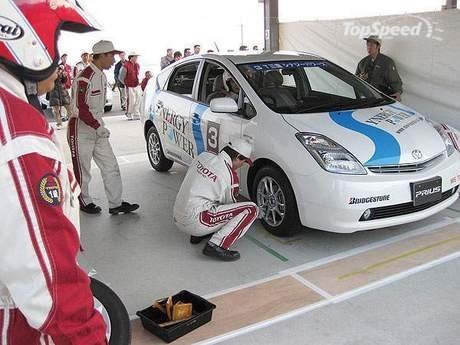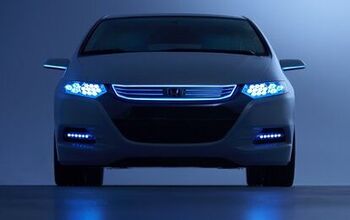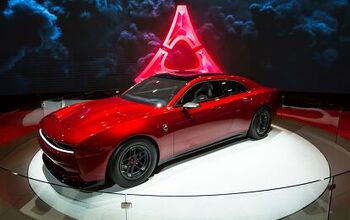Editorial: Star Search

Let’s get one thing straight: There are very few inanimate objects which inspire my personal distaste, contempt, and revulsion as much as the Toyota Prius does. It’s a sad, sick, suppository-shaped little plastic box which exists for the sole purpose of letting spoiled, faux-progressive Americans feel virtuous as they continue to consume the lion’s share of the world’s finite resources. I will go to my grave believing that the Japanese Government subsidized its development for the purposes of economic warfare on the United States, and that the Prius lost money for years in a way that no automotive nameplate that does not begin with “Aston” would consider even vaguely defensible. Sometimes, the Prius even kills its own assembly-line workers. In my perfect world, it would extend the same service to its smug, open-mouthed, emo-glasses-wearing, lane-blocking owners.
I could go on, but you get the point: I hate the car. And yet, when I read Jay Shoemaker’s infamous single-star review of the latest model, I cannot help but think that in his place, I would have given the blandmobile from Toyota City four stars . . . or, whisper it, five.
TTAC stands virtually alone among major automotive news sources in providing its reviewers carte blanche to review a vehicle as they see fit. The flip side to this is that the reviewer is understood to speak for himself, not for the site as a whole. The road tests in magazines like Car and Driver are intended to represent the opinion of that magazine, not that of Tony Swan or Patrick Bedard in particular, so the opinions of the individual writer are smothered beneath a leveling flow of groupthink. The reader is therefore reassured that Car and Driver conducts all its reviews using approximately the same standard, and that one may read individual reviews of competing products and obtain a useful comparison by doing so.
Bland consistency is the secret behind Ray Kroc’s billions and billions served, but it holds no sway on this website. Our reviewers judge cars by widely different standards. The new Mustang? I loved it, but Farago thinks it’s lousy! Our methodologies differ widely. Sajeev Mehta examines assembly quality, Robert considers market positioning, I recently took a drum-rear-braked Ford Focus to a public trackday and passed an Exige by cutting an entire corner on the track and showering the Hethel hearse with dirt and rocks. We’re all different and we’re all permitted to have our say.
With this in mind, I’d like to receive some guidance from TTAC readers as to how I rate cars, and if the other reviewers choose to take heed as well, that is up to them. From my reading of the comments surrounding Jay’s test, I have concluded that there are three major suggested rating methodologies:
1. Rate the car in accordance with how well it performs its particular intended mission. We rate the Prius on its efficiency, the Veyron on top speed, and the Sonata on how well it matches up to the Accord.
2. Take the core qualities of a car for granted and rate it on its ability to perform other tasks. We assume the Prius is efficient, so we judge it based on excitement or aesthetics. We know a Veyron is quick, so we rate it based on its usability.
3. Consider how the vehicle stands within the overall automotive marketplace and rate it accordingly, adjusting for price or not as you see fit.
Let me take those in reverse order. I’m not a fan of “overall rating”. Consider the Honda Civic. Compared to a BMW 335i, the Civic is a piece of garbage. Compared to an Elantra . . . not so much. Which comparison is more important? Nor do I like the idea of rigorously price-adjusting ratings, because it leads to comparison tests where the Infiniti G37 “beats” the aforementioned 335i despite being wholeheartedly inferior.
The second idea, advanced by several TTACers in the Prius-test comments, also leaves me a bit nervous. I don’t like the idea of rating a Lotus Elise on storage capacity. You could argue that most of the major magazines use #2 as their guide, which leads to universal praise for well-rounded cars like the Honda Accord. The Accord’s a great car, but for some people the Altima is better and for others the Camry would satisfy more, precisely because those two vehicles stray from the “all-rounder” idea to emphasize individual features.
Which leaves us with #1. That’s how I like to rate a car. The Mustang GT500 is a five-star car because it’s the best ponycar you can get, the Prius is probably a five-star car because no other hybrid delivers the unique features and experience to the same extent, and the BMW Z4 is not a five-star car because it falls short to the Boxster in all the ways that really matter.
What do you, the TTACer, think? I’ll read all the comments, attempt to figure out what the majority opinion is, and deliver my next review (the 2010 Ford Fusion SE Duratec six-speed) to your specifications.

More by Jack Baruth
Latest Car Reviews
Read moreLatest Product Reviews
Read moreRecent Comments
- SCE to AUX "we had an unprecedented number of visits to the online configurator"Nobody paid attention when the name was "Milano", because it was expected. Mission accomplished!
- Parkave231 Should have changed it to the Polonia!
- Analoggrotto Junior Soprano lol
- GrumpyOldMan The "Junior" name was good enough for the German DKW in 1959-1963:https://en.wikipedia.org/wiki/DKW_Junior
- Philip I love seeing these stories regarding concepts that I have vague memories of from collector magazines, books, etc (usually by the esteemed Richard Langworth who I credit for most of my car history knowledge!!!). On a tangent here, I remember reading Lee Iacocca's autobiography in the late 1980s, and being impressed, though on a second reading, my older and self realized why Henry Ford II must have found him irritating. He took credit for and boasted about everything successful being his alone, and sidestepped anything that was unsuccessful. Although a very interesting about some of the history of the US car industry from the 1950s through the 1980s, one needs to remind oneself of the subjective recounting in this book. Iacocca mentioned Henry II's motto "Never complain; never explain" which is basically the M.O. of the Royal Family, so few heard his side of the story. I first began to question Iacocca's rationale when he calls himself "The Father of the Mustang". He even said how so many people have taken credit for the Mustang that he would hate to be seen in public with the mother. To me, much of the Mustang's success needs to be credited to the DESIGNER Joe Oros. If the car did not have that iconic appearance, it wouldn't have become an icon. Of course accounting (making it affordable), marketing (identifying and understanding the car's market) and engineering (building a car from a Falcon base to meet the cost and marketing goals) were also instrumental, as well as Iacocca's leadership....but truth be told, I don't give him much credit at all. If he did it all, it would have looked as dowdy as a 1980s K-car. He simply did not grasp car style and design like a Bill Mitchell or John Delorean at GM. Hell, in the same book he claims credit for the Brougham era four-door Thunderbird with landau bars (ugh) and putting a "Rolls-Royce grille" on the Continental Mark III. Interesting ideas, but made the cars look chintzy, old-fashioned and pretentious. Dean Martin found them cool as "Matt Helm" in the late 1960s, but he was already well into middle age by then. It's hard not to laugh at these cartoon vehicles.


































Comments
Join the conversation
Truly.
[...] http://www.thetruthaboutcars.com/editorial-star-search/Sajeev Mehta examines assembly quality, Robert considers market positioning, I recently took a drum-rear-braked Ford Focus to a public trackday and passed an Exige by cutting an entire corner on the track and showering the Hethel hearse with dirt and rocks. …. Although the Prius is not for me (I’d like a Fusion hybrid wagon myself), I’m thankful there are thousands of people who like them enough to save a lot of fuel by driving a high mpg car. Their purposes for doing … [...]